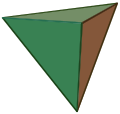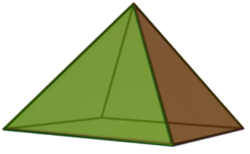Pyramid (geometry)
In geometry, a pyramid is a polyhedron formed by connecting a polygonal base and a point, called the apex. Each base edge and apex form a triangle, called a lateral face. A pyramid is a conic solid with a polygonal base. Many types of pyramids can be found by determining the shape of bases, either by based on a regular polygon (regular pyramids) or by cutting off the apex (truncated pyramid). It can be generalized into higher dimensions, known as hyperpyramid. All pyramids are self-dual.
Etymology
[edit]The word "pyramid" derives from the ancient Greek term "πυραμίς" (pyramis), which referred to a pyramid-shaped structure and a type of wheat cake.[1][2] The term is rooted in the Greek "πυρ" (pyr, 'fire') and "άμις" (amis, 'vessel'), highlighting the shape's pointed, flame-like appearance.[3]
In Byzantine Greek, the term evolved to "πυραμίδα" (pyramída), continuing to denote pyramid structures.[4] The Greek term "πυραμίς" was borrowed into Latin as "pyramis." The term "πυραμίδα" influenced the evolution of the word into "pyramid" in English and other languages.[5][6]
Definition
[edit]
A pyramid is a polyhedron that may be formed by connecting a polygonal base and a point, called the apex. Each base edge and apex form an isosceles triangle called a lateral face.[7] The edges connected from the polygonal base's vertices to the apex are called lateral edges.[8] Historically, the definition of a pyramid has been described by many mathematicians in ancient times. Euclides in his Elements defined a pyramid as a solid figure, constructed from one plane to one point. The context of his definition was vague until Heron of Alexandria defined it as the figure by putting the point together with a polygonal base.[9]
A prismatoid is defined as a polyhedron where its vertices lie on two parallel planes, with its lateral faces as triangles, trapezoids, and parallelograms.[10] Pyramids are classified as prismatoid.[11]
Classification and types
[edit]The terms "Right pyramid" and "Regular pyramid" are used to describe special cases of pyramids. There are no standard definitions for these terms, and different sources use them somewhat differently. The common notion is that Regular pyramid is one with a regular polygon as its base, and a right pyramid is one where the axis (the line joining the centroid of the base and the apex) is perpendicular to the base[12][13][14]. Some sources define the term right pyramid only as a special case for regular pyramids[15], while others define it for the general case of any shape of a base. Other sources define only the term right pyramid to include within its definition the regular base[16]. Rarely, a right pyramid is defined to be a pyramid whose base is circumscribed about a circle and the altitude of the pyramid meets the base at the circle's center.[17]
For the pyramid with an n-sided regular base, it has n + 1 vertices, n + 1 faces, and 2n edges.[18] Such pyramid has isosceles triangles as its faces, with its symmetry is Cnv, a symmetry of order 2n: the pyramids are symmetrical as they rotated around their axis of symmetry (a line passing through the apex and the base centroid), and they are mirror symmetric relative to any perpendicular plane passing through a bisector of the base.[19][20] Examples are square pyramid and pentagonal pyramid, a four- and five-triangular faces pyramid with a square and pentagon base, respectively; they are classified as the first and second Johnson solid if their regular faces and edges that are equal in length, and their symmetries are C4v of order 8 and C5v of order 10, respectively.[21][22] A tetrahedron or triangular pyramid is an example that has four equilateral triangles, with all edges equal in length, and one of them is considered as the base. Because the faces are regular, it is an example of a Platonic solid and deltahedra, and it has tetrahedral symmetry.[23][24] A pyramid with the base as circle is known as cone.[25] Pyramids have the property of self-dual, meaning their duals are the same as vertices corresponding to the edges and vice versa.[26] Their skeleton may be represented as the wheel graph, that is they can be depicted as a polygon in which its vertices connect a vertex in the center called the universal vertex.[27]
A right pyramid may also have a base with an irregular polygon. Examples are the pyramids with rectangle and rhombus as their bases. These two pyramids have the symmetry of C2v of order 4.
The type of pyramids can be derived in many ways. The base regularity of a pyramid's base may be classified based on the type of polygon: one example is the star pyramid in which its base is the regular star polygon.[28] The truncated pyramid is a pyramid cut off by a plane; if the truncation plane is parallel to the base of a pyramid, it is called a frustum.
Mensuration
[edit]The surface area is the total area of each polyhedra's faces. In the case of a pyramid, its surface area is the sum of the area of triangles and the area of the polygonal base.
The volume of a pyramid is the one-third product of the base's area and the height. The pyramid height is defined as the length of the line segment between the apex and its orthogonal projection on the base. Given that is the base's area and is the height of a pyramid, the volume of a pyramid is:[29] The volume of a pyramid was recorded back in ancient Egypt, where they calculated the volume of a square frustum, suggesting they acquainted the volume of a square pyramid.[30] The formula of volume for a general pyramid was discovered by Indian mathematician Aryabhata, where he quoted in his Aryabhatiya that the volume of a pyramid is incorrectly the half product of area's base and the height.[31]
Generalization
[edit]
The hyperpyramid is the generalization of a pyramid in n-dimensional space. In the case of the pyramid, one connects all vertices of the base, a polygon in a plane, to a point outside the plane, which is the peak. The pyramid's height is the distance of the peak from the plane. This construction gets generalized to n dimensions. The base becomes a (n − 1)-polytope in a (n − 1)-dimensional hyperplane. A point called the apex is located outside the hyperplane and gets connected to all the vertices of the polytope and the distance of the apex from the hyperplane is called height.[32]
The n-dimensional volume of a n-dimensional hyperpyramid can be computed as follows: Here Vn denotes the n-dimensional volume of the hyperpyramid. A denotes the (n − 1)-dimensional volume of the base and h the height, that is the distance between the apex and the (n − 1)-dimensional hyperplane containing the base A.[32]
References
[edit]- ^ "Henry George Liddell, Robert Scott, A Greek-English Lexicon, πυραμίς", www.perseus.tufts.edu.
- ^ The word meant "a kind of cake of roasted wheat-grains preserved in honey"; the Egyptian pyramids were named after its form. See Beekes, Robert S. (2009), Etymological Dictionary of Greek, Brill, p. 1261.
- ^ Liddell, Henry George; Scott, Robert (1940). A Greek–English Lexicon. Clarendon Press.
- ^ "πυραμίδα". Wiktionary. 12 July 2022. Retrieved 30 June 2024.
- ^ Lewis, Charlton T.; Short, Charles (1879). A Latin Dictionary. Clarendon Press.
- ^ Peck, Harry Thurston (1898). Harper's Dictionary of Classical Antiquities. Harper & Brothers.
- ^ Cromwell, Peter R. (1997), Polyhedra, Cambridge University Press, p. 13.
- ^ Smith, James T. (2000), Methods of Geometry, John Wiley & Sons, p. 98, ISBN 0-471-25183-6.
- ^ Heath, Thomas (1908), Euclid: The Thirteen Books of the Elements, vol. 3, Cambridge University Press, p. 268.
- ^ Alsina, Claudi; Nelsen, Roger B. (2015), A Mathematical Space Odyssey: Solid Geometry in the 21st Century, Mathematical Association of America, p. 85, ISBN 978-0-88385-358-0.
- ^ Grünbaum, Branko (1997), "Isogonal Prismatoids", Discrete & Computational Geometry, 18: 13–52, doi:10.1007/PL00009307.
- ^ O'Leary, Michael (2010), Revolutions of Geometry, John Wiley & Sons, p. 10, ISBN 978-0-470-59179-6.
- ^ Weisstein, Eric W, Pyramid, MathWorld--A Wolfram Web Resource
- ^ Bartol, William C. (1893), The Elements of Solid Geometry, Leach Shewell & Sanborn, p. 32
- ^ Gellert, Gottwald, Hellwich, Kastner, Kustner (1989), The VNR CONCISE ENCYCLOPEDIA OF MATHEMATICS, Van Nostrand Reinhold, ISBN 978-94-011-69844
{{citation}}: CS1 maint: multiple names: authors list (link) - ^ Davies, Charles (1852), Elements of Geometry and Trigonometry, A. S. Barnes & Co., p. 175
- ^ Polya, G. (1954), Mathematics and Plausible Reasoning: Induction and analogy in mathematics, Princeton University Press, p. 138, ISBN 0-691-02509-6.
- ^ Humble, Steve (2016), The Experimenter's A-Z of Mathematics: Math Activities with Computer Support, Taylor & Francis, p. 23, ISBN 978-1-134-13953-8.
- ^ Johnson, Norman W. (2018), Geometries and Transformations, Cambridge University Press, ISBN 978-1-107-10340-5. See Chapter 11: Finite Symmetry Groups, 11.3 Pyramids, Prisms, and Antiprisms.
- ^ Alexandroff, Paul (2012), An Introduction to the Theory of Groups, Dover Publications, p. 48, ISBN 978-0-486-48813-4.
- ^ Johnson, Norman W. (1966), "Convex polyhedra with regular faces", Canadian Journal of Mathematics, 18: 169–200, doi:10.4153/cjm-1966-021-8, MR 0185507, S2CID 122006114, Zbl 0132.14603. See table III, line 1.
- ^ Uehara, Ryuhei (2020), Introduction to Computational Origami: The World of New Computational Geometry, Springer, p. 62, doi:10.1007/978-981-15-4470-5, ISBN 978-981-15-4470-5.
- ^ Shavinina, Larisa V. (2013), The Routledge International Handbook of Innovation Education, Routledge, p. 333, ISBN 978-0-203-38714-6.
- ^ Cundy, H. Martyn (1952), "Deltahedra", The Mathematical Gazette, 36 (318): 263–266, doi:10.2307/3608204, JSTOR 3608204, S2CID 250435684.
- ^ Kelley, W. Michael (2009), The Humongous Book of Geometry Problems, Penguin Group, p. 455, ISBN 978-1-61564-698-2.
- ^ Wohlleben, Eva (2019), "Duality in Non-Polyhedral Bodies Part I: Polyliner", in Cocchiarella, Luigi (ed.), ICGG 2018 - Proceedings of the 18th International Conference on Geometry and Graphics: 40th Anniversary - Milan, Italy, August 3-7, 2018, Advances in Intelligent Systems and Computing, vol. 809, Springer, p. 485–486, doi:10.1007/978-3-319-95588-9, ISBN 978-3-319-95588-9
- ^ Pisanski, Tomaž; Servatius, Brigitte (2013), Configuration from a Graphical Viewpoint, Springer, p. 21, doi:10.1007/978-0-8176-8364-1, ISBN 978-0-8176-8363-4.
- ^ Wenninger, Magnus J. (1974), Polyhedron Models, Cambridge University Press, p. 50, ISBN 978-0-521-09859-5, archived from the original on 2013-12-11
- ^ Alexander, Daniel C.; Koeberlin, Geralyn M. (2014), Elementary Geometry for College Students (6th ed.), Cengage Learning, p. 403, ISBN 978-1-285-19569-8.
- ^ Gillings, R. J. (1964), "The volume of a truncated pyramid in ancient Egyptian papyri", The Mathematics Teacher, 57 (8): 552–555, doi:10.5951/MT.57.8.0552, JSTOR 27957144.
- ^ Cajori, Florian (1991), History of Mathematics (5th ed.), American Mathematical Society, p. 87, ISBN 978-1-4704-7059-3.
- ^ a b Mathai, A. M. (1999), An Introduction to Geometrical Probability: Distributional Aspects with Applications, Taylor & Francis, p. 42–43, ISBN 978-90-5699-681-9.












